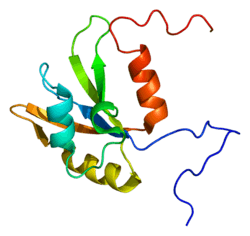HNRPF
Heterogeneous nuclear ribonucleoprotein F is a protein that in humans is encoded by the HNRNPF gene.[5][6]
This gene belongs to the subfamily of ubiquitously expressed heterogeneous nuclear ribonucleoproteins (hnRNPs). The hnRNPs are RNA binding proteins that complex with heterogeneous nuclear RNA (hnRNA). These proteins are associated with pre-mRNAs in the nucleus and regulate alternative splicing, polyadenylation, and other aspects of mRNA metabolism and transport. While all of the hnRNPs are present in the nucleus, some seem to shuttle between the nucleus and the cytoplasm. The hnRNP proteins have distinct nucleic acid binding properties. The protein encoded by this gene has three repeats of quasi-RRM domains that bind to RNAs which have guanosine-rich sequences. This protein is very similar to the family member hnRPH. Multiple alternatively spliced variants, encoding the same protein, have been identified.[6]
References
- 1 2 3 GRCh38: Ensembl release 89: ENSG00000169813 - Ensembl, May 2017
- 1 2 3 GRCm38: Ensembl release 89: ENSMUSG00000042079 - Ensembl, May 2017
- ↑ "Human PubMed Reference:".
- ↑ "Mouse PubMed Reference:".
- ↑ Honore B, Rasmussen HH, Vorum H, Dejgaard K, Liu X, Gromov P, Madsen P, Gesser B, Tommerup N, Celis JE (Jan 1996). "Heterogeneous nuclear ribonucleoproteins H, H', and F are members of a ubiquitously expressed subfamily of related but distinct proteins encoded by genes mapping to different chromosomes". J Biol Chem. 270 (48): 28780–9. doi:10.1074/jbc.270.48.28780. PMID 7499401.
- 1 2 "Entrez Gene: HNRPF heterogeneous nuclear ribonucleoprotein F".
Further reading
- McDonald H, Smailus D, Jenkins H, et al. (1992). "Identification and characterization of a gene at D10S94 in the MEN2A region". Genomics. 13 (2): 344–8. doi:10.1016/0888-7543(92)90251-M. PMID 1351868.
- Matunis MJ, Xing J, Dreyfuss G (1994). "The hnRNP F protein: unique primary structure, nucleic acid-binding properties, and subcellular localization". Nucleic Acids Res. 22 (6): 1059–67. doi:10.1093/nar/22.6.1059. PMC 307930. PMID 7512260.
- Gamberi C, Izaurralde E, Beisel C, Mattaj IW (1997). "Interaction between the human nuclear cap-binding protein complex and hnRNP F." Mol. Cell. Biol. 17 (5): 2587–97. PMC 232108. PMID 9111328.
- Chou MY, Rooke N, Turck CW, Black DL (1999). "hnRNP H is a component of a splicing enhancer complex that activates a c-src alternative exon in neuronal cells". Mol. Cell. Biol. 19 (1): 69–77. PMC 83866. PMID 9858532.
- Honoré B, Vorum H, Baandrup U (1999). "hnRNPs H, H' and F behave differently with respect to posttranslational cleavage and subcellular localization". FEBS Lett. 456 (2): 274–80. doi:10.1016/S0014-5793(99)00911-4. PMID 10456323.
- Yoshida T, Kokura K, Makino Y, et al. (2000). "Heterogeneous nuclear RNA-ribonucleoprotein F binds to DNA via an oligo(dG)-motif and is associated with RNA polymerase II". Genes Cells. 4 (12): 707–19. doi:10.1046/j.1365-2443.1999.00295.x. PMID 10620016.
- Markovtsov V, Nikolic JM, Goldman JA, et al. (2000). "Cooperative assembly of an hnRNP complex induced by a tissue-specific homolog of polypyrimidine tract binding protein". Mol. Cell. Biol. 20 (20): 7463–79. doi:10.1128/MCB.20.20.7463-7479.2000. PMC 86300. PMID 11003644.
- Zhang Y, Lindblom T, Chang A, et al. (2001). "Evidence that dim1 associates with proteins involved in pre-mRNA splicing, and delineation of residues essential for dim1 interactions with hnRNP F and Npw38/PQBP-1". Gene. 257 (1): 33–43. doi:10.1016/S0378-1119(00)00372-3. PMID 11054566.
- Veraldi KL, Arhin GK, Martincic K, et al. (2001). "hnRNP F influences binding of a 64-kilodalton subunit of cleavage stimulation factor to mRNA precursors in mouse B cells". Mol. Cell. Biol. 21 (4): 1228–38. doi:10.1128/MCB.21.4.1228-1238.2001. PMC 99576. PMID 11158309.
- Jia L, Young MF, Powell J, et al. (2002). "Gene expression profile of human bone marrow stromal cells: high-throughput expressed sequence tag sequencing analysis". Genomics. 79 (1): 7–17. doi:10.1006/geno.2001.6683. PMID 11827452.
- Jurica MS, Licklider LJ, Gygi SR, et al. (2002). "Purification and characterization of native spliceosomes suitable for three-dimensional structural analysis". RNA. 8 (4): 426–39. doi:10.1017/S1355838202021088. PMC 1370266. PMID 11991638.
- Angenstein F, Evans AM, Settlage RE, et al. (2002). "A receptor for activated C kinase is part of messenger ribonucleoprotein complexes associated with polyA-mRNAs in neurons". J. Neurosci. 22 (20): 8827–37. PMID 12388589.
- Strausberg RL, Feingold EA, Grouse LH, et al. (2003). "Generation and initial analysis of more than 15,000 full-length human and mouse cDNA sequences". Proc. Natl. Acad. Sci. U.S.A. 99 (26): 16899–903. doi:10.1073/pnas.242603899. PMC 139241. PMID 12477932.
- Ota T, Suzuki Y, Nishikawa T, et al. (2004). "Complete sequencing and characterization of 21,243 full-length human cDNAs". Nat. Genet. 36 (1): 40–5. doi:10.1038/ng1285. PMID 14702039.
- Honoré B, Baandrup U, Vorum H (2004). "Heterogeneous nuclear ribonucleoproteins F and H/H' show differential expression in normal and selected cancer tissues". Exp. Cell Res. 294 (1): 199–209. doi:10.1016/j.yexcr.2003.11.011. PMID 14980514.
- Deloukas P, Earthrowl ME, Grafham DV, et al. (2004). "The DNA sequence and comparative analysis of human chromosome 10". Nature. 429 (6990): 375–81. doi:10.1038/nature02462. PMID 15164054.
- Beausoleil SA, Jedrychowski M, Schwartz D, et al. (2004). "Large-scale characterization of HeLa cell nuclear phosphoproteins". Proc. Natl. Acad. Sci. U.S.A. 101 (33): 12130–5. doi:10.1073/pnas.0404720101. PMC 514446. PMID 15302935.
- Gerhard DS, Wagner L, Feingold EA, et al. (2004). "The status, quality, and expansion of the NIH full-length cDNA project: the Mammalian Gene Collection (MGC)". Genome Res. 14 (10B): 2121–7. doi:10.1101/gr.2596504. PMC 528928. PMID 15489334.
- Rush J, Moritz A, Lee KA, et al. (2005). "Immunoaffinity profiling of tyrosine phosphorylation in cancer cells". Nat. Biotechnol. 23 (1): 94–101. doi:10.1038/nbt1046. PMID 15592455.







